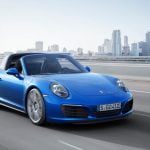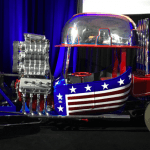Among the electric cars at the 2017 LA Auto Show are a BMW 2019 i8 Roadster plug-in hybrid, left, the BMW i Vision Dynamics electric concept car and a Mini Cooper plug-in hybrid. (Kevork Djansezian / Getty Images)
Petroleum products still power nearly all the cars driving the world’s highways, minus a nano-point or two for the rare alternative-fuel vehicle. But something new is stirring. Call it elektrifizierung.
That’s German for electrification. While big American companies — and to a large extent, the Koreans and the Japanese — keep their electric efforts low-key, European carmakers, led by the German Big Three, are aggressively dramatizing their strategic shift toward electrified powertrains at the Los Angeles Convention Center.
Visitors who walk past BMW’s exhibit encounter a huge sign declaring that transition and a promise of 25 electrified models by 2025. The company’s most recent entry, the plug-in hybrid i8 Roadster sports car, sits underneath, its burnt-orange butterfly-wing doors and aggressive styling attracting wide-eyed viewers.
BMW’s Mini brand will produce an electric in 2019, and the company reportedly is considering making its entire Mini lineup pure electric.
Stroll down the aisle to Mercedes-Benz and you’ll encounter a row of “new energy” cars: the plug-in hybrid GLE-550e and C-Class C350e, and the GLC F-Cell, which employs a hydrogen fuel cell, not the usual battery, to generate electricity. The brand plans to offer electrified versions of every car in its lineup by 2022.
The Volkswagen exhibit is a must-see for the e-curious. Three all-electric concept vehicles under the I.D. brand name are on prominent display, each one looking bright and cheerful and cartoon-cute. There is a hatchback, a crossover and a modern take on the classic VW Bus, the I.D. Buzz.
The hatchback goes on sale in 2019, with the Buzz and the Crozz crossover some unidentified months after that. But because they are concept cars, it’s hard to know what features will make it into early production. The hatchback is presented with a steering wheel that telescopes flat into the dash for full-scale driverless operation.
“This is just a glimpse of what’s to come,” a well-dressed VW representative told a gathering crowd.
Despite all the attention on electrification, most of the cars being touted in L.A. are plug-in hybrids. Most of the pure electrics are concept cars.
But the European automakers are promising a flood of electrified vehicles of all varieties starting in 2019 or 2020, with momentum building to mid-decade. VW promises 50 electric models and 30 hybrids across all its brands — which include Audi, Porsche, SEAT and Skoda — by 2025. Porsche already offers a four-door Panamera plug-in hybrid, and the all-electric Mission-E sports car is slated for 2019.
Also set for 2019 is the all-electric Jaguar I-Pace small SUV. Jaguar, the luxury brand now owned by India’s Tata Motors, signals its commitment to an electric future at its L.A. display with a race car for Formula E, the electric-car version of Formula 1 racing that recently began its fourth season in Hong Kong.
While it’s unclear how quickly and in what numbers customers will embrace electric cars, BMW board member Klaus Frölich told reporters, “For us, electric mobility is the new normal. … We will deliver whatever powertrain our customers desire.”
The automakers may have to manufacture desire for electrics until car buyers get comfortable with the new offerings.
Absent strong demand, two things are pushing the industry toward electrics. The big one is government policy. All the major markets — Western Europe, China, the United States — have combined mandates with subsidies and other incentives that favor electric cars to reduce greenhouse gases and other pollutants.
Europe and China, both essential markets for the Germans and for Jaguar, seem committed to carry through with policies that tighten the pressure on gas- and diesel-powered vehicles year by year. The Trump administration, however, is reviewing Obama-era clean-air policies for possible reduction, and the Republican tax cuts, if passed, would remove the $7,500 federal incentive for the purchase of an electric car.
The other push is the emergence of Tesla, which now sells about 100,000 high-end electric cars a year. Tesla’s success is used by policymakers to counter arguments that people aren’t interested in buying electric cars. (Tesla this year has a display on the main floor at the auto show for the first time in years.)
Electric cars may continue to make more inroads among high-end customers. Carmakers like Germany’s Audi are banking on it. The luxury car market has softened in recent years, and Scott Keogh, Audi of America’s president, said he’s convinced electrified cars will perk up growth for Audi and the luxury segment in general. The brand plans to introduce three all-electric vehicles in 2020.
“Our customers are highly educated, part of the creative class. They want to make a difference,” he said. “They’re the kind of customers who want to buy cool things.”
It’s been years since electric cars lagged on the performance front. High-end electric cars sport zero-to-60 times equal to or better than gasoline engines. Tesla says its recently introduced $200,000 Roadster will run that course in 1.9 seconds.
“It’s easier to sell in the premium segment,” said Matthias Erb, head of engineering and product strategy for Volkswagen, which owns Audi.
But he predicts that as prices come down over the years, VW’s upper-middle class customers will begin gravitating to e-vehicles in large numbers.
Maybe that’s why the Japanese car companies, more tailored to the mass market, won’t be offering all-electrics in bulk until 2030. Nissan is showing off its newly designed Leaf at the auto show. Its back end no longer looks like a Leaf, a change that has been met with widespread approval. Honda and Hyundai each offer electric versions of their compact Clarity and Ioniq.
American carmakers are more reserved with their electric offerings. You have to search through the Ford display to find the few electrified models, and the company has no electric concept cars at the show. Ford recently announced it no longer will sell the C-Max plug-in hybrid compact because of a lack of demand.
At Fiat Chrysler, you need to walk through the Dodge muscle cars to reach a Pacifica plug-in hybrid minivan.
General Motors promises 20 new electrics by 2023, but you wouldn’t know that by what’s on display at the auto show. No e-action at Buick, or at Cadillac, though there’s a huge model of a V-8 engine on display.
At Chevy, that lone little critter sitting between a massive Silverado High Country 4-by-4 pickup and a pair of high-horsepower Corvettes is the Chevy Bolt EV, the world’s first long-range, mid-market all-electric car. It’s won acclaim from car reviewers, but Chevy sells only a few thousand a month — a good start, perhaps, but at the auto show, it’s a tiny minority in a world of combustion.
Electrics “are still a very small segment of the marketplace,” said Alec Gutierrez, an analyst at Kelley Blue Book.
Ask the floor representatives at the auto show why the Europeans seem so excited about electric cars while the Americans, not so much, and you get modest shrugs and slow-motion head shakes and looks that say “don’t ask me stuff like that.”
One domestic carmaker rep spoke up, but only on condition of not being named (“I don’t want to get in trouble”).
“Auto shows are run by dealers,” she said. “They want to show off the cars they can sell now.”
[“Source-ndtv”]





